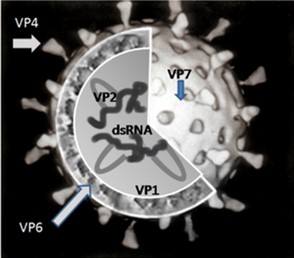
Scientists Animate Devouring Stars
by SH staff January 31, 2018
Crisp winter evenings are an excellent time to go star-gazing and be filled with awe of God’s creation. While you look unto the heavens scientists are busy in their labs studying star-shaped structures that will provide “hope” to mankind through biotechnology.
Researchers are experimenting with a tiny virus called bacteriophage phi-6, in order to gain understanding on more complex viruses. A bacteriophage also known as a Phage Φ6 is a virus that infects and replicates within a bacterium. The term was derived from “bacteria” and the Greek : φαγεῖν (phagein), “to devour” opening a star-gate to an artificial bacterial genome.
A new technology called cryo-electron microscopy or cryo-EM are allowing researchers to capture at near atomic level 3D detail structure of the immature bacteriophage phi-6 at the point of replication.
At the points of the star key proteins (red) are positioned to transport clipped, single-strand segments of the virus own genetic information into a newly made shell, or procapsid (blue). Once inside the procapsid and enzyme (purple) will copy the segments to make the genetic information double-stranded while another protein (yellow) will help package them. As this procapsid matures it undoes dramatic structural changes.
This virus is easy to work with in the lab and contains the blueprint of RNA so it is the perfect candidate to study double-stranded RNA viruses such as the rotovirus that make people ill including a bug which infects children causing the ‘stomach flu’ and claims 450,000 children each year.
While this many sound like a noble cause scientist are perfecting the science of deploying viruses hidden in bacteria to accomplish various tasks from medication deliver to switching genetic codes within our bodies on and off, and creating complex novel pathogens that mankind and animals have no ability to fight off. Is the real purpose to devour the human genome and replace it with a synthetic one?
So during this holiday season as you gaze up at the twinkling stars say a prayer for humanity as scientists around the world diligently manipulate the “stars.” It would be far better to make a wish upon a star than to further exploit the handiwork of God through biotechnology.
Sources and Reference:
[1] Rotavirus (Centers for Disease Control and Prevention)
Links:
Developing the First Rotavirus Vaccine (Intramural Research Program/NIH)
Alasdair Steven (National Institute of Arthritis and Musculoskeletal and Skin Diseases/NIH)
NIH Support: National Institute of Arthritis and Musculoskeletal and Skin Diseases




